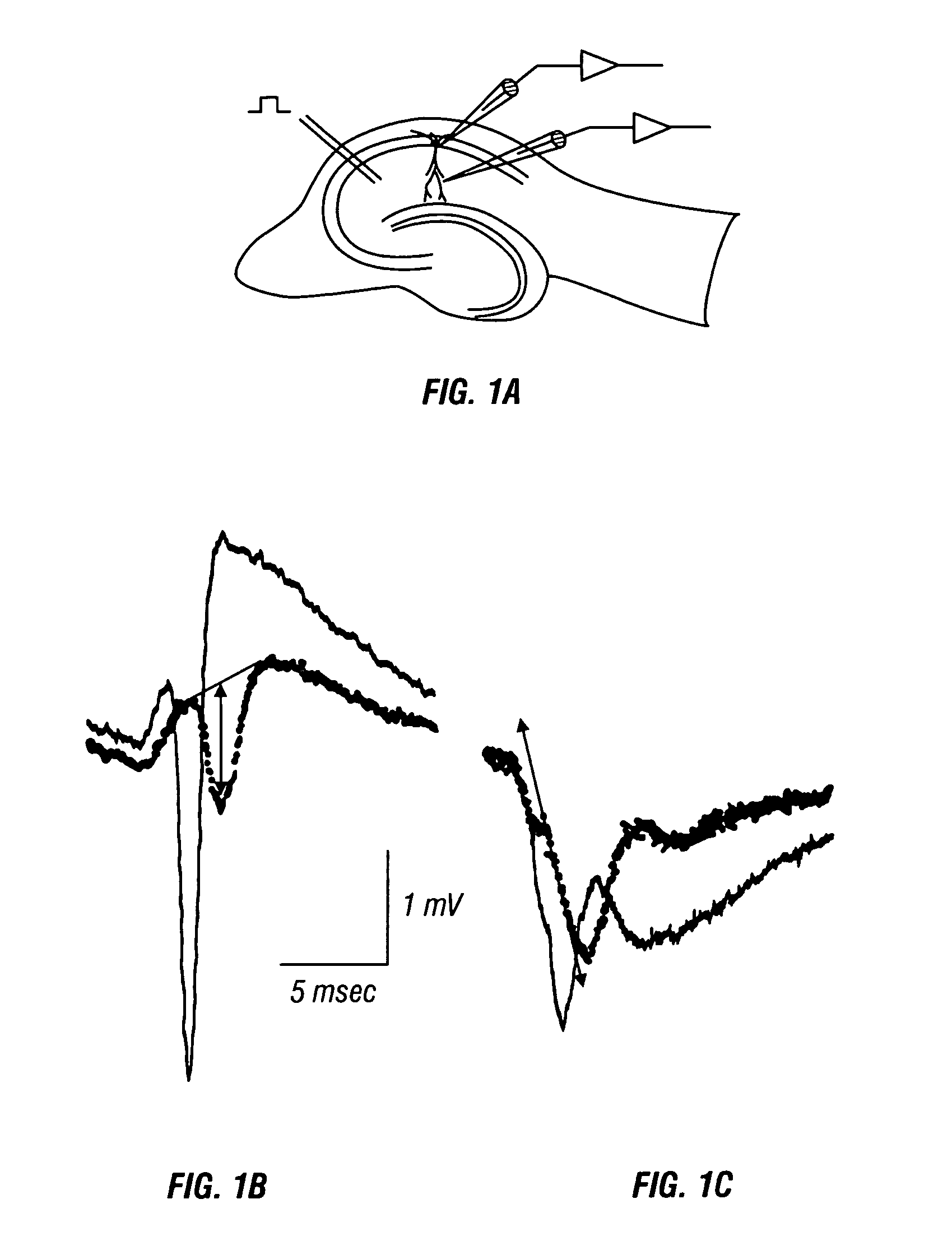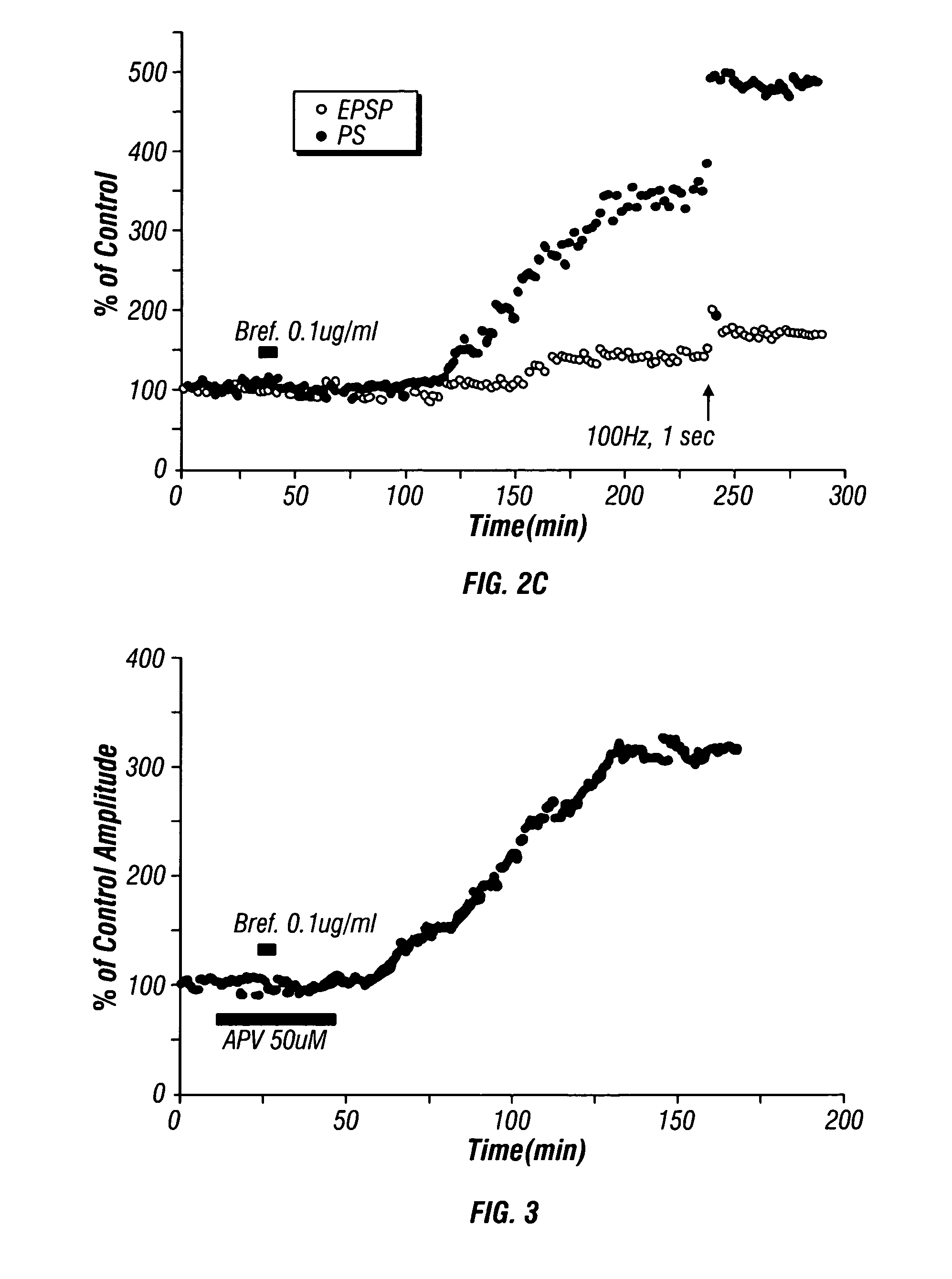Drugs to improve synaptic transmission
a synaptic transmission and drug technology, applied in the field of enhanced learning potential drugs, can solve the problems of increasing the effect of epsps on the dendritic membrane potential, reducing the electrical resistance between the spine and the rest, and no longer producing ltp from electrical stimulation of the hippocampus, so as to increase the efficiency of synaptic transmission, safe induce ltp, and enhance cognitive function
- Summary
- Abstract
- Description
- Claims
- Application Information
AI Technical Summary
Benefits of technology
Problems solved by technology
Method used
Image
Examples
example 1
[0058]Transverse slices (500 μm) were cut from the hippocampi of 4–8 week-old rats (or Guinea pigs weighing 300–400 g), submerged, and continuously perfused at 2–3 ml / min with oxygenated artificial cerebrospinal fluid (10 mM NaCl; 5 mM KCl; 1.3 mM NaH2PO4; 1.9 mM MgSO4.7 H2O; 22 mM NaHCO3) at 30° C. Excitatory post-synaptic potentials were elicited every 5 seconds by stimulation of Schaffer collateral / commissural fibers with bipolar tungsten stimulating electrodes. Stimulation and recording electrodes were placed as shown in FIG. 1A into the pyramidal cell layer of CA1 region and the stratum radiatum for extracellular recordings of the) population spike (PS) and field excitatory postsynaptic potential (EPSP), respectively. A bipolar stimulation electrode positioned in the stratum radiatum was used to stimulate Schaffer collateral / commissural fibers.
[0059]PS were recorded from the CA1 pyramidal cell layer before and after BA (0.05–0.5 μg / ml; MW=280.37) application with glass microele...
example 2
[0062]Studies were conducted to determine the time course of induction of LTP by BA in hippocampal tissue. The amplitude of PS was recorded in a several control hippocampal slices as shown in FIG. 2A. Fluctuations of PS amplitude were within ±20% of baseline during the recording. Upon application of tetanus of 100 Hz for 1 sec at t=15, the amplitudes of PS recorded increased from about 2 mV to about 6 mV (FIG. 2B). In tetanic-induced LTP, the PS amplitude increased immediately after tetanus of 100 Hz for one second and reached a plateau level within several minutes which was higher than that before tetanus.
[0063]As shown in FIG. 2C, when BA was administered to hippocampal tissue at t=50 minutes the PS amplitude and slope of EPSP began to increase approximately 60 minutes after BA application at t=10 minutes. About a four-fold increase (400% that of the control slice) in PS occurred by t=240 minutes, and a small increase in the slope of the field EPSP was observed. Upon administratio...
example 3
[0064]An experiment was conducted to measure BA-induced (0.1 μg / ml) increase in LTP in a hippocampal slice prepared as in Example 1 in the presence of APV, a N-methyl-D-aspartate (NMDA) receptor blocker. Administration of a 50 μM solution of APV was commenced at t=10 minutes and continued until t=50 minutes. As shown in FIG. 3, administration of 0.1 μg / ml of BA in the artificial cerebral spinal fluid of Example 1 at about t=25 minutes resulted in a three-fold increase in the amplitude of PS over that of the same slice before BA application. This demonstrates NMDA receptor independent induction of LTP by BA.
PUM
| Property | Measurement | Unit |
|---|---|---|
| Dimensionless property | aaaaa | aaaaa |
| Dimensionless property | aaaaa | aaaaa |
| Time | aaaaa | aaaaa |
Abstract
Description
Claims
Application Information
 Login to View More
Login to View More - R&D
- Intellectual Property
- Life Sciences
- Materials
- Tech Scout
- Unparalleled Data Quality
- Higher Quality Content
- 60% Fewer Hallucinations
Browse by: Latest US Patents, China's latest patents, Technical Efficacy Thesaurus, Application Domain, Technology Topic, Popular Technical Reports.
© 2025 PatSnap. All rights reserved.Legal|Privacy policy|Modern Slavery Act Transparency Statement|Sitemap|About US| Contact US: help@patsnap.com



